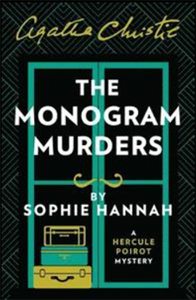Nearly a century after Agatha Christie invented Hercule Poirot, another writer was given the go-ahead to put words in his mouth for the first time, with Sophie Hannah’s “The Monogram Murders” (2014). Well, not precisely the first time. Every time an episode of “Poirot” featured scenes not in Christie’s text, other writers were shaping Poirot’s character and legend.
Although Hannah picks up the Poirot baton one year after the David Suchet series ended, she deftly stays true to Christie’s portrayal in “The Monogram Murders.” The author emphasizes Poirot’s arrogance and confidence in this 1929 London case.
Agatha Christie meets Thomas Harris?
She also leans toward the grisly side of Christie and perhaps a little beyond that line. In a posh hotel, three people are found dead, “respectfully” posed like a corpse would be when handled by officials, and with monogrammed cufflinks in their mouths. It’s not totally in the realm of Thomas Harris – who stuffs insects into corpses’ throats in “The Silence of the Lambs” – but it’s surprisingly close.

“The Monogram Murders” (2014)
Author: Sophie Hannah
Series: New Hercule Poirot Mysteries No. 1
Genre: Mystery
Setting: 1929, London
Even more so than the posing of the deceased, the psychology of the people involved is quite weird. Hannah, as is her wont, digs into people’s mental makeup and how it affects their actions. Apparently, at least three people were involved in a murder-suicide pact because they felt bad about their past mistreatment of a vicar and his wife. Such an extreme self-inflicted punishment for a moral lapse seems unlikely.
While the mystery is a notch above middling, “Monogram” stands out as a character piece. As noted, Hannah quite simply knows how to write Poirot. She has obviously read every story featuring the sleuth and soaked up his mannerisms and traits. Having already published seven mysteries at this point, her writing skill is such that Poirot flows smoothly through this book; he’s never a forced imitation.
Where Hannah diverges from Christie is in her specific mystery interests. Yes, Poirot often solves cases with his knowledge of human psychology, but with Hannah it’s an absolute certainty that the answers are to be found by analyzing people’s behavior.
With mental health being more in the mainstream today than in 1929, Hannah’s Poirot books can feel mildly out of time. I’m not arguing for Poirot to time travel to the 21st century by any means, but Poirot’s knowledge of psychology in “Monogram” is remarkable even by his own high standards.
Enter: Catchpool
An understated but impressive Hannah invention is Poirot’s helper, Edward Catchpool, a 30-ish Scotland Yard detective. At one point, Poirot compares him to Hastings – both so Hannah can acknowledge the elephant in the room (“Where’s Hastings?”) and to admit that, yes, Catchpool has things in common with Hastings.

Notably, Catchpool — the audience surrogate narrator — is frustrated that Poirot has figured things out but won’t tell him anything just yet. (“All in good time, mon ami” and all that.) And at one point, Catchpool says something that accidentally sends Poirot down the correct path of inquiry, as Hastings often does.
But Catchpool is different from Hastings in two key areas. For one, Hastings is a locked-in character; he can’t grow. Hannah can do whatever she wants with Catchpool. If the Christie estate decided it didn’t want any more Poirots from Hannah (which is unlikely, as her fifth is coming out later this year), she couldn’t publish new ones. But she would be free to write solo Catchpool stories that show how Poirot has made him a better detective.
Secondly, Catchpool – rather than being distracted by every pretty face like Hastings – is annoyed by the idea of being set up with eligible bachelorettes. He’s focused on his job, and a reader could argue that Catchpool is non-romantic, a type of person that’s rare in the populace but gets nearly zero representation in fiction.
Amusement comes from Poirot breaking into his Papa Poirot mode – noting that Catchpool and tea-shop proprietress Fee Spring are hitting it off well – and Catchpool being annoyed and flustered.
A solid start
In terms of the mystery’s solvability, Hannah will do better in future books. “Monogram” includes a passage wherein a small-town drunk spews information in such an unclear way that it’s hardly worth it for Catchpool and the reader to try to sort it out.
The author plays fair in the end – and caps it with a grand Poirot announcement in the hotel ballroom — but this novel is overloaded with characters and background and forks in the road.
Still, Poirot is in vintage form, Catchpool is a great partner, and everyone is a fully developed person – even if it’s implausible that someone would choose to kill themselves as punishment for basic bad behavior. There’s only one Christie, but “The Monogram Murders” proves that Hannah has Poirot in capable, respectful hands.
Sleuthing Sunday reviews an Agatha Christie book or adaptation. Click here to visit our Agatha Christie Zone.

